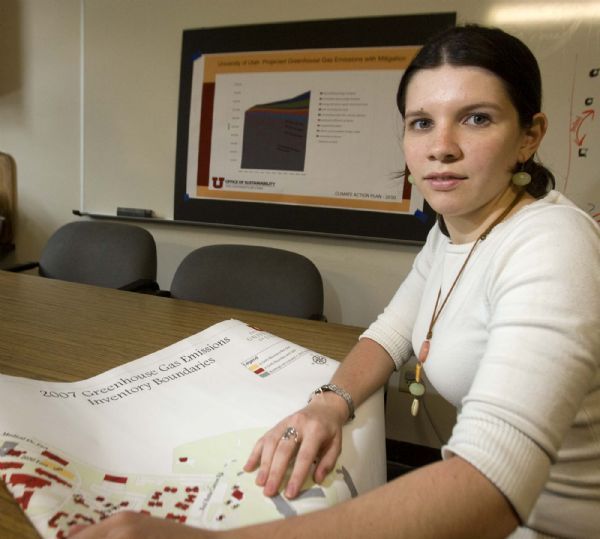This is an archived article that was published on sltrib.com in 2010, and information in the article may be outdated. It is provided only for personal research purposes and may not be reprinted.
Imagine burning the contents of 14 million propane cylinders, the five-gallon kind hanging from your backyard barbecue. Besides grilling a lot of meat, the resulting conflagration would release as much carbon dioxide, 339,000 metric tons, as what society emits to keep the University of Utah humming each year.
Graduate student Sofia Melo calculated the U.'s emissions and discovered 38 percent comes from the coal burned to generate the staggering electrical loads consumed on campus. But a surprisingly high portion, 17 percent, comes in the form of jet exhaust associated with air travel, Melo said.
How much the U.'s greenhouse gas emissions contribute to global climate change may be open to debate, but the state's flagship and three other Utah schools are moving forward with plans to eliminate their carbon footprints by 2050, preferably much sooner.
President Michael Young ordered the U.'s plan, previewed before trustees on Tuesday, to meet obligations he incurred when he signed the American College and University Presidents' Climate Commitment two years ago.
"By bringing bright minds together and through thoughtful, decisive action, the University of Utah is leading the way in its commitment and response to key climate issues and working to create a more responsible, sustainable world in which to live and learn," Young said in a media statement.
His Carbon Neutrality Action Plan, which will be finalized this summer, will outline strategies to achieve this goal by reduction of solid waste, curbing energy and water consumption, investing in renewable energy, discouraging personal vehicle use, installing high-efficiency fixtures in renovations and new construction, and paying for carbon "offsets," which are projects, such as planting trees, that help offset carbon emissions, Office of Sustainability director Myron Willson told trustees.
"This is smart business whether you think carbon is an issue," trustees chairman Randy Dryer said.
So far, 685 other institutions have signed the pledge, including Utah's Westminster College, Weber State University and Utah State University.
"Campuses that address the climate challenge by reducing global warming emissions and by integrating sustainability into their curriculum will better serve their students and meet their social mandate to help create a thriving, ethical and civil society," the commitment states. "These colleges and universities will be providing students with the knowledge and skills needed to address the critical, systemic challenges faced by the world in this new century and enable them to benefit from the economic opportunities that will arise as a result of solutions they develop."
The universities' carbon-reduction pledges swim against political currents in Utah, where many state leaders actively resist the notion that fossil fuel burning is warming the planet. While the National Academy of Sciences has declared human-caused climate change a grave threat, a majority in the Legislature formalized their opposition to carbon-emission reduction programs in a non-binding resolution last session. And Gov. Gary Herbert's 10-year energy plan will not address climate change.
"That creates an interesting question for the [Board of] Regents and the university," Regent David Jordan counseled trustees. "If carbon neutrality is your goal, you will run into political resistance, but when you talk about this in terms of energy savings and pollution reduction you get near-universal acceptance."
Willson said the U. already has policies in place that are driving down emissions and eliminating the first 40 percent of the footprint, which will save the university money. But those savings will likely be consumed as the university invests in the offsets needed to achieve full carbon neutrality.
"We lack the information to be more aggressive at this time," Willson said. "We will emphasize voluntary programs. None of this can be on the taxpayers."
The plan will be fine-tuned every three years to account for new information and technologies. Major research institutions with hospitals, like the U., will face special challenges because of their need for freezers, chilled water and powerful ventilation.
"Things like fume hoods require energy because [of] the volumes of air they move out of buildings that have to be replaced at a heated or cooled temperature," said Paul Rowland, executive director of the Association for the Advancement of Sustainability in Higher Education. "The flip of that is we are finding challenges for community colleges because they have so many commuters. It turns out that is a huge contribution."
Melo, a student in the U.'s master of science and technology program, is among the 80 students and faculty helping craft the plan.
She conducted the carbon inventory for 2007, the commitment's baseline year, calculating electricity, natural gas and liquid fuels consumption, miles of commuting and air travel, volume of solid waste directed to landfills, and other activities associated with operating the 30,000-student campus.
The university's footprint equaled that of 29,000 homes or the amount of carbon locked in 72,000 acres of evergreen forest, according to the EPA's equivalence calculator. If the U. takes no action those emissions will climb to 466,000 metric tons by 2025 and 625,000 by 2050, Willson said.
The U.'s carbon footprint: major contributors
Energy consumption in 2007 and resulting carbon dioxide emissions in metric tons
Liquid fuels, 750,000 gallons; emissions 7,000 metric tons
Electricity, 300 million kilowatts; 127,000 metric tons
Natural gas, 1.3 million MMBtu*; 73,000 metric tons
Air travel, 74 million miles; 57,000 metric tons
Commuting, 207 million miles**; 72,000 metric tons
Solid waste, 2,500 tons diverted to landfills; 400 metric tons
*million British thermal units
**includes public transportation and personal vehicles
Source University of Utah, Office of Sustainability



